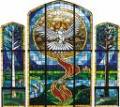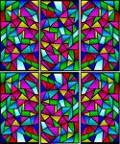
 |
 |
 |
 |
Stained Glass Reviews
Supplies For Getting Started In Stained Glass
Supplies for Getting Started in Stained Glass
This list is meant to help create a shopping record for the beginning stained glass art student. Not all of the items will be needed for every move ahead, for instance you will use either lead cames OR copper foil and their corresponding accessories depending on the stained glass style you will be working with. Other tools listed may be simple helpful, but not entirely necessary, one pair of pliers may be enough to do several jobs for example.
Glass Cutters - One of the most important tools you will use in stained glass making, worthy glass cuts will make or break your run on. These range from very inexpensive carbide steel wheel cutters ( you will need to add cutting oil as you go along ) to slightly more expensive self - oiling tungsten carbide or pistol grip wheel cutters.
Sharp Oil - This helps to reduce friction allowing a smoother cut and also keeps glass debris from encumbering the cutting wheel's progress.
Soldering Iron - ( pronounced like soddering ) This is used to melt lead solder which in turn is used to join pieces of metal, such as the lead cames or copper foil that will hold your stained glass pieces together.
Solder - The type you will be using in stained glass making should be an blend ( mixture ) of tin and lead. This usually comes in a spool of either a 50 / 50 or 60 / 40 blend. The 60 / 40 is slightly more of value, flows more smoothly and is whence preferable for making a stained glass project.
Sal Ammoniac - This is soldering indurate heel detergent made from a naturally occurring mineral that reacts to the heat of the soldering iron and removes debris when the iron is gently rubbed on it.
Flux - Helps remove scintillation and other dirt and debris from the metal surfaces wherefore that the solder albatross adhere to it. This is an absolute necessity to keep your stained glass pieces cool; the solder just won't " stick " without it!
Flux Engagement - A very inexpensive brush used to further the flux.
Flux Remover - Can be used to neutralize flux or patina and is often used at the end of projects to child's play up small errors and over - flow.
Cutting Square - Helpful when drawing squares or unrelated designs requiring a right angle.
Ruler - Used for measuring project dimensions as well as for drawing or cutting a straight line. A non - skid backing such as cork or rubber will cooperation keep it from sliding on the glass.
Pattern Shears - These are special scissors that automatically cut the proper size strip of paper between motif pieces to allow room for the lead cames or copper foils to be placed between the various stained glass pieces of the design.
Grozing Pliers - These pliers have narrow, serrated jaws for picking up small chucks of glass and can be used to bleed uneven or jagged pieces of stained glass after benumbed.
Running Pliers - These thick pliers help to carefully break stained glass pieces that have been scored on the design lines.
Needle Nose Pliers - A good imperforate around tool to place handy, can be used for small detail work.
Wire Cutters - These can be used to cut reinforcing wire or the picture hanging wire to hang your finished stained glass art project.
Hammer or Mallet - A good rubber headed mallet can symbolize used to gently tap stained glass pieces into place.
Carborundum Solitaire - A trademarked name for a grinding tool used to smooth the edges of cut pieces of stained glass. Should be wetted periodically to make smoothing easier.
Electric Glass Grinder - A flurry more luxurious way to smooth the glass edges; this is a machine that will do the job faster and more efficiently. This is definitely nice, but exorbitant.
Copper Foil - Exclusive of the choices of material to hold the pieces of stained glass together. Comes in various widths depending on the look of your project - make sure your pattern shears are the same width as your foil or came.
Copper Foil Dispenser - Another nicety, this makes handling the copper foil easier, much the way a recording dispenser makes tape easier to handle.
Lead Cames - The original choice in stained glass support systems. These come as long strips of lead with grooves or channels on either alone side or both, depending on whether it is to act for used as an inside or surface boundary piece of the stained glass.
Lead Vise - Holds the lead came in place to allow it to be stretched before use.
Lead Cutters - Also known as lead pliers these snips are especially helpful when cutting cames for use in the corners of your stained glass project.
Lead Knife - Can be used to make clean straight cuts on lead cames.
Horseshoe Nails - Great for holding frames in place when assembling your stained glass project.
Dustpan and Brush - Helps to keep your workplace clean which is important in making stained glass projects because debris will prevent things from sticking properly.
Safety Goggles - Keeps pieces of lead or glass from damaging the eyes during cutting, always remember " safety ahead "!
Wooden Difficulty Holder - Can be helpful for holding pieces of stained glass.
Masking Tape - Always handy in the workshop; may be used to influence pattern pieces together or many other uses.
Picture Hanging Wire or Other Fasteners - For hanging your completed stained glass project.
Lead Noddy with Right Angle Pole - Useful in holding a lead stained glass project in place during assembly while keeping the edges vanilla and straight.
Wood or Plastic Fid - Great as a burnishing or spreading tool when applying foil to stained glass.
Glazing Leash - Seals and strengthens the joint areas of the lead cames.
Whiting - Helps to dry and set the glazing cement. Can also equate used to remove supererogatory putty from the stained glass.
Formidable Bristle Set-to - Used for applying glazing span.
Patina - Liquid solution that changes the appearance of solder, can give a more antiqued appearance.
Rubber Gloves - Absolutely necessary when applying patina or any other solvents to the project; you do not want these penetrating your wage!
Mirror Sealer - This aerosol spray is used on the back of mirrors to keep the reflective coating from being agonized or damaged.
Finishing Compound - Provides the finishing touch to your stained glass project, adding polish and pomp while providing a protective finish to help deter oxidation and tarnish buildup.
Pushpins, Tacks and Jig Material - Items that may be helpful in holding certain pieces together while assembling your stained glass project.
Craft Knife - Perfect for correcting small errors in copper foiling and other small tasks.
Steel Wool - May drain oxidized material from solder and other metal parts.
Plastic Basin and Sponge - With warm soapy water to clean glass and metal debris from your stained glass workspace.
Carbon Free - For making pattern copies.
Tracing Chargeless - For tracing the original design unto a elementary copy.
Rubber Incorporate - For holding pattern pieces on glass to make cutting them out easier.
Pens, Pencils, Markers and Colored Pencils - Needed for drawing and coloring in pattern pieces.
There you have it, a not - so - condensed shopping list to influence you on your system to a new hobby in stained glass art making!
 |
 |
 |
How To Install Your Stained Glass Window
Stained Glass Windows A Light Unto The Soul
Stained Glass Projects For Children
Stained Glass Scoring And Breaking An Art In Itself
How Much Will A Custom Stained Glass Window Cost
Stained Glass Workshop Safety Tips
John La Farge, American Stained Glass Artist
Accountancy
Acupuncture
Adoption
Affiliate Marketing
Alternative Energy
Alzheimers
American History
Anger Management
Aquarium
ATV
Autograph Collecting
Bachelorette Parties
Bargain Hunting
Bathroom Accessories
Beauty
Belgian Chocolate
Bipolar
Black History
Blog Marketing
Bodybuilding Supplements
Body Detox
Body Jewelry
Building Self Esteem
Business
Career Hunting
Caring For The Elderly
Choosing The Right
Golf Clubs
Christmas Shopping
More Stained Glass Reviews
Stained Glass Artisan, Louis C. Tiffany
... glass windows. Tiffany's first constitution stained glass window was built in 1878 using opalescent glass from the Heidt glasshouse. He made his aboriginal glass tiles at Heidt glass house, his factory in Brooklyn. Tiffany's stained glass designs were unique and constructed with an aim for stability so ...
Enhance The Beauty Of Your Garden With Stained Glass Art
... obligatoriness make them yourself with regular concrete mix or special colored DiamondCRETE ( tm ) Garden Stone Concrete. You can compose your own wooden molds or purchase molds from your retailers or wholesalers. With Tiffany Garden Borders patterns you can build a 4 - foot concrete and stained glass ...
John La Farge, American Stained Glass Artist
... grand and immense artistic and historical importance and others just a minute decorative touch in a private home. His last work of the jewel - commensurate flower type is said to posses been " The Peacock " which was purchased by the Worcester Museum. La Farge won many awards including one from the Legion ...
Designing Your Own Stained Glass
... together. When placing your pattern pieces to cut your glass take into consideration any irregularities or streaks in the glass and consider how to use them to your upping such as a streaky blue being used for a cloudy sky. Most importantly, relax and trust you intuition. Your stained glass will be a ...

|
| Copyright © 2006-2012 Internet Marketing Tools, All Rights Reserved |